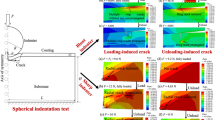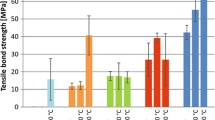Abstract
The interfacial adhesion measurement of a ceramic coating on a metal substrate is studied by three-point bending (3PB) technique. In the measurement, interfacial cracks are induced during the 3PB test, and the interfacial energy release rate is calculated from the released energy per unit crack surface area during crack extension under the fixed displacement conditions. A finite element analysis (FEA) model encompassing the plastic behavior of the metal substrate is developed to simulate the 3PB test and extract the energy data. The inputs to the FEA model include the crack length, the maximum and critical loads corresponding to crack initiation, and the mechanical properties of the coating and substrate. A MoB/CoCr ceramic coating/stainless steel substrate system is investigated by the technique for demonstrating the utility of the technique.







Similar content being viewed by others
References
Jansen, F, Wei, XH, Dorfman, MR, Peters, JA, Nagy, DR, “Performance of dicalcium silicate coatings in hot-corrosive environment.” Surf. Coat. Technol., 149 57-61 (2002) doi:10.1016/S0257-8972(01)01381-0.
Afrasiabi, A, Saremi, M, Kobayashi, A, “A comparative study on hot corrosion resistance of three types of thermal barrier coatings: YSZ, YSZ +Al2O3 and YSZ/Al2O3.” Mater. Sci. Eng. A, 478 264-269 (2008) doi:10.1016/j.msea.2007.06.001.
Maiti, AK, Mukhopadhyay, N, Raman, R, “Effect of adding WC powder to the feedstock of WC-Co-Cr based HVOF coating and its impact on erosion and abrasion resistance.” Surf. Coat. Technol., 201 7781-7788 (2007) doi:10.1016/j.surfcoat.2007.03.014.
Souza, VAD, Neville, A, “Corrosion and synergy in a WCCoCr HVOF thermal spray coating–understanding their role in erosion-corrosion degradation.” Wear, 259 171-180 (2005) doi:10.1016/j.wear.2004.12.003.
Padture, NP, Gell, M, Jordan, EH, “Thermal barrier coatings for gas-turbine engine Applications.” Science, 296 280-284 (2002) doi:10.1126/science.1068609.
Padture, NP, Schlichting, KW, Bhatia, T, Ozturk, A, Cetegen, B et al., “Towards durable thermal barrier coatings with novel microstructures deposited by solutionprecursor plasma spray.” Acta Mater., 49 2251-2257 (2001) doi:10.1016/S1359-6454(01)00130-6.
Chen, XJ, Chen, GN, Zhang, K, Luo, GX, Xiao, JH, “On the thermally induced interfacial delamination of a segmented coating.” Surf. Coat. Technol., 202 2878-2884. (2008) doi:10.1016/j.surfcoat.2007.10.031.
Chen, ZX, Wang, ZG, Yuan, FH, Zhu, SJ, “Interfacial fracture behavior of a thermal barrier coating system under four-point bend loading.” Mater. Sci. Eng. A, 483-484 629-32 (2008) doi:10.1016/j.msea.2007.01.166.
Mittal, KL, Adhesion Measurement of thin films, thick films, and bulk coatings. ASTM, Philadelphia (1978).
Volinsky, AA, Moody, NR, Gerberich, WW, “Interfacial toughness measurements for thin films on substrates.” Acta Mater., 50 441-466 (2002) doi:10.1016/S1359-6454(01)00354-8.
Houérou, V.L., Gauthier, C., Schirrer, R., “Energy based model to assess interfacial adhesion using a scratch test.” J. Mater. Sci., 43 5747-5754 (2008) doi:10.1007/s10853-008-2869-6.
Shaviv, R, Roham, S, Woytowitz, P, “Optimizing the precision of the four-point bend test for the measurement of thin film adhesion.” Microelectro. Eng., 82 99-120 (2005) doi:10.1016/j.mee.2005.06.006.
Dauskardt, RH, Lane, M, Ma, Q, Krishna, N, “Adhesion and debonding of multi-layer thin film structures.” Eng. Fract. Mech., 61 141-162 (1998) doi:10.1016/S0013-7944(98)00052-6.
Li, H, Khor, KA, Cheang, P, “Adhesive and bending failure of thermal sprayed hydroxyapatite coatings: Effect of nanostructures at interface and crack propagation phenomenon during bending.” Eng. Fract. Mech., 74 1894-1903 (2007) doi:10.1016/j.engfracmech.2006.06.001.
Turner, MR, Dalgleish, BJ, He, MY, Evans, AG, “A fracture resistance measurement method for bimaterial interfaces having large debond energy.” Acta Metall. Mater., 43 3459-3465 (1995) doi:10.1016/0956-7151(95)00037-V.
Bull, SJ, Berasetegui, E.G, “An overview of the potential of quantitative coating adhesion measurement by scratch.” Tribol. Int., 39 99-114 (2006) doi:10.1016/j.triboint.2005.04.013.
Marot, G, Lesage, J, Démarécaux, Ph, Hadad, M, Siegmann, St, Staia, MH, “Interfacial indentation and shear tests to determine the adhesion of thermal spray coatings.” Surf. Coat. Technol., 201 2080-2085 (2006) doi:10.1016/j.surfcoat.2006.04.046.
Cordill, MJ, Bahr, DF, Moody, NR, Gerberich, WW, “Recent developments in thin film adhesion measurement.” IEEE Trans. Dev. Mater. Reliab., 4 163-168 (2004) doi:10.1109/TDMR.2004.829071.
Chicot, D, Araujo, P, Horny, N, Tricoteaux, A, Lesage, J, “Application of the interfacial indentation test for adhesion toughness determination.” Surf. Coat. Technol., 200 174-77 (2005) doi:10.1016/j.surfcoat.2005.02.045.
Banholzer, B, Brameshuber, W, Jung, W, “Analytical evaluation of pull-out tests–The inverse problem.” Cement and Concrete Compos., 28 564-571 (2006) doi:10.1016/j.cemconcomp.2006.02.015.
Greenhalgh, E, Lewis, A, Bowen, R, Grassi, M, “Evaluation of toughening concepts at structural features in CFRP–Part I: Stiffener pull-off.” Compos. Part A, 37 1521-1535 (2006) doi:10.1016/j.compositesa.2005.11.009.
Anderson, TL, Fracture Mechanics: Fundamentals and Applications. CRC Press, Boca Raton (1995).
Hutchinson, JW, Suo, Z, “Mixed model cracking in layered materials.” Adv. Appl. Mech., 29 63-91 (1992) doi:10.1016/S0065-2156(08)70164-9.
Elizald, MR, Sánchez, JM, Martínez-Esnaola, J et al., “Interfacial fracture induced by cross-sectional nanoindentation in metal-ceramic thin film structures.” Acta Mater., 51 4295-4305 (2003) doi:10.1016/S1359-6454(03)00256-8.
Sánchez, JM, EL-Mansy, S, Sun, B, Scherban, T, Fang, N et al., “Cross-sectional nanoindentation: A new technique for thin film interfacial adhesion characterization.” Acta Mater., 47 4405-4413 (1999) doi:10.1016/S1359-6454(99)00254-2.
Bao, YW, Zhou, YC, Bu, XX, Qiu, Y, “Evaluating elastic modulus and strength of hard coatings by relative method.” Mater. Sci. Eng. A, 458 268-274 (2007) doi:10.1016/j.msea.2006.12.131.
Rouzaud, André, Barbier, E, Ernoult, J, Quesnel, E, “A method for elastic modulus measurements of magnetron sputtered thin films dedicated to mechanical applications.” Thin Solid Films 270 270-274 (1995) doi:10.1016/0040-6090(95)06921-6.
Beghini, M, Bertini, L, Frendo, F, “Measurement of Coatings’ Elastic Properties by Mechanical Methods: Part 1. Consideration on Experimental Errors.” Exper. Mech. 41 293-304 (2001) doi:10.1007/BF02323922.
Beghini, M, Benamati, G, Bertini, L, Frendo, F, “Measurement of coatings’ elastic properties by mechanical methods Part 2. Application to thermal barrier coatings.” Exper. Mech., 41 305-311 (2001) doi:10.1007/BF02323923.
ABAQUS, Reference Manuals, Version 6.5. Hibbit, Karlsson and Sorensen, Providence, RI (2004)
Parks, DM, “The virtual crack extension method for Non-linear material behavior.” Comp. Meth. In Appl. Mech. Eng., 12 353-364 (1977).
Hellen, TK, “On the method of virtual crack extensions.” Int. J. Num. Meth. Eng., 9 187-207 (1975) doi:10.1002/nme.1620090114.
Jensen, HM, “The blister test for interface toughness measurement.” Eng. Fract. Mech., 40 475-486 (1991) doi:10.1016/0013-7944(91)90144-P.
Nie, PL, Shen, Y, Chen, QL, Cai, X, “Effects of residual stresses on interfacial adhesion measurement.” Mech. Mater., 41 545-552 (2009) doi:10.1016/j.mechmat.2009.01.022.
Li, H, Khor, KA, Cheang, P, “Young’s modulus and fracture toughness determination of high velocity oxy-fuel-sprayed bioceramic coatings.” Surf. Coat. Tech., 155 21-32 (2002) doi:10.1016/S0257-8972(02)00026-9.
Acknowledgments
The study was financially supported by Hong Kong Research Grants Council (RGC) through Competitive Earmarked Research Grant (CERG) No. CityU 112307.
Author information
Authors and Affiliations
Corresponding author
Rights and permissions
About this article
Cite this article
Nie, P., Lv, H., Zhou, T. et al. Interfacial adhesion measurement of a ceramic coating on metal substrate. J Coat Technol Res 7, 391–398 (2010). https://doi.org/10.1007/s11998-009-9192-2
Published:
Issue Date:
DOI: https://doi.org/10.1007/s11998-009-9192-2




